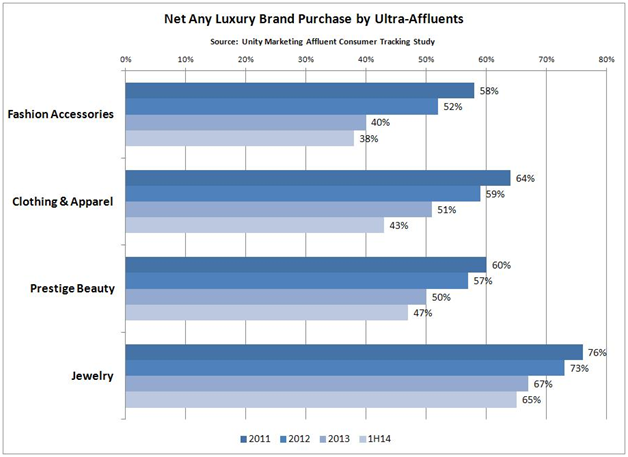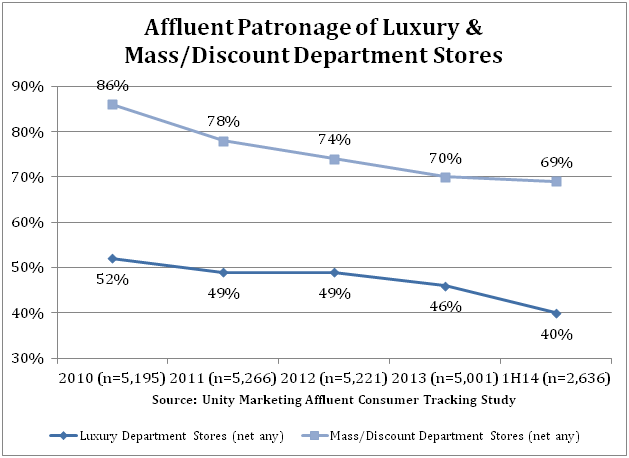Unity Marketing's look at the most important trends for marketers targeting the U.S. affluent customer

In recent blog posts, we’ve explored the top trends shaping the luxury market in 2015. The overriding trend that will impact all marketers at the high-end is that affluents have settled into a mood of austerity. One way that affluents' austere mood is expressed is in a new style of shopping which trends toward mass rather than 'class,' and preference for premium, rather than heritage luxury brands.
Ultra-Affluents are trading down, rather than up
Within the nearly 28 million segment of affluent households, defined as families with income at the top 20%, there are two discrete groups:
- HENRYs (High Earners Not Rich Yet), the mass-affluent with incomes from $100k-$249.9k, which number just over 24 million; and
- Ultra-affluents, those with incomes $250k and above, totaling 3.3 million households.
The mass-affluent HENRYs do not feel affluent, rather they view themselves very much as members of the 'middle-class.' As such, HENRYs are watching their pennies and saving their discretionary income, rather than spending it. HENRYs rarely trade up to luxury brands, though they did much more freely before the Great Recession. They also shop widely in more mass-market oriented stores.
Ultra-affluents, who top the income pyramid, tend to feel financially stable; indeed, they have plenty of money to afford true luxury, yet they are hesitant to call themselves out as 'affluent' and are turning to less conspicuous consumption. Their spending is going under-cover toward these types of purchases:
- Private things, like things for their home, such as art, furniture, top of the line appliances, or;
- Things and experiences to be enjoyed privately in their home, think expensive wine and spirits, entertaining, gourmet food;
- Not showy or conspicuous purchases, such as brands with subtle logos and markings, or;
- Things bought online, where the Fedex truck delivers the goods and nobody sees them walking down the street with a Neiman Marcus, Barney’s or Bergdorf Goodman bag.
But, regardless of ultra-affluents' capability to spend quite freely on luxury, the simple fact is they are much more frequently trading down, rather than up to luxury. They are finding it hard to justify spending three, or five or even ten times more for a heritage luxury item which isn't three, or five or ten times better than a comparable item at a much lower price. Today, affluents have a plethora of products readily available via their computers, tablets or smart phones with the same or nearly the same level of quality, workmanship and materials.
As a result, ultra-affluents are cutting back on their purchases of heritage luxury brands, in favor of purchases of premium brands, like Coach, Michael Kors, Ralph Lauren, and Tiffany. For example, Unity Marketing has tracked a steady decline of ultra-affluent purchases of any luxury brands in fashion accessories, clothing and apparel, prestige beauty and jewelry from 2011 through the first half of 2014. This presents challenges for luxury brands to connect with those customers who have the highest potential to spend, but who are now turning away from many of these high-end brands.

As the ultra-affluents have cut back indulging in luxury brands, they are spending less on luxury goods and services. For example, Unity Marketing has tracked ultra-affluent spending on luxury and high-end goods and services since 2004. Typically, the ultra-affluents spent 3-to-4 times more than HENRYs. However, in 2012 and ever since, the spending gap has narrowed to about two-times as much. In effect, with the spending gap between ultra-affluents and HENRYs closing, ultra-affluents are shopping more like the mass-affluent HENRYs than ever.
In keeping with their mood of austerity and value-oriented shopping, ultra-affluents shop far more often at Target than Neiman Marcus. The idea that ultra-affluents want to spend as much money as they can is ludicrous. They shop for value and when they can get good-enough brands at reasonable prices, they will opt for that. They don’t need the prestige of shopping at Bergdorf Goodman, Saks 5th Avenue or other ‘tony’ stores. They shop across all types of stores, but with mass and discount retailers, like Macy’s, Target, Costco, and Kohl's getting a greater share of their patronage.

Luxury marketers challenge for 2015: To put the luxe back in luxury
Ultra-affluents don’t feel like they belong to the luxury class anymore. Thus, they are trading down to less luxurious brands toward premium, even mass brands. This creates new opportunities in the premium space, as well as challenges for those that continue to strive for the pinnacle of luxury. For years, for decades, and in some cases for centuries, luxury brand marketing has been based on the concept of elitism and that ownership of a certain brand confers special status to the individual. The concept of elitism is expressed by claims of exclusivity, design excellence and workmanship. It is supposed to create desire for luxury brands that one aspires to own and to show off. But, today's affluent just aren't buying those ideas anymore. They are looking for something new and different with a view toward quality and value. Luxury brands must deliver on those promises and find new ways of connecting with a class of affluents that don't need status symbols any longer.
To learn more about the trends, download Pam Danziger's free white paper, Five Luxe Trends for 2015, and stay tuned as we highlight more trends on the blog. Also, check out the trends we've already covered, including affluent austerity, luxury's new style and luxury brands' evolving story, on our blog.
Editor's Note:
This post was written by Pam Danziger, President of Unity Marketing.
About Unity Marketing
Drawing upon their extensive industry experience, as well as professional expertise in marketing research and analysis, product and concept development, strategic planning and licensing, Unity Marketing offers marketing research that helps clients identify and maximize their potential success in the collectibles and giftware markets. Unity Marketing utilizes a full range of quantitative and qualitative research to address its clients' marketing challenges.


